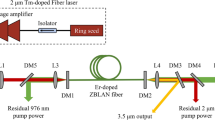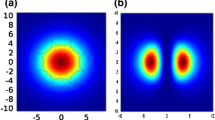Abstract
Yb3+-sensitized Er3+-doped fibers are attracting increasing interest because of the high achievable performances, such as high gain and pump efficiency. High output power can be obtained from a double clad (dc) Er3+/Yb3+ co-doped fiber pumped with broad area high power pump laser diodes. The principle of amplification in this kind of co-doped fibers is presented in this paper. Different solutions for the injection of pump power in the 1st-cladding have been described. The energy transfer mechanism in a Er3+/Yb3+ co-doped system including cooperative-upconversion process is explained. Gain and absorption properties ofdc fibers have been determined experimentally and inserted in a theoretical amplifier model. Good agreement between measurements and modelling has been obtained. Hybrid Er3+-Er3+/Yb3+ amplifier architectures are suitable to obtain + 30 dBm output power. The gain bandwidth is in the 1535–1565 nm range for single wavelength operation. A spectral gain flatness is observed in a reduced C-bandWDM operation (i.e. 1545–1565 nm) without gain-flattening filter. Nonlinear effects such as the optical Kerr effect or the stimulated Brillouin scattering can be observed in high power amplifiers due to the high output peak power confined in the fiber core. These two nonlinear phenomena have been investigated for different high power amplifier configurations. Numerical modelling have also confirmed the observed signal distortions.
Résumé
Les fibres co-dopées Er3+/Yb3+ présentent un grand intérêt car des gains élevés et de grandes efficacités de pompage peuvent être obtenus. Une puissance de sortie élevée est possible avec une fibre co-dopée Er3+/Yb3+ à double gaine pompée par une diode de puissance de large surface d’émission. Différentes techniques d’injection de la puissance de pompe dans la 1ère gaine sont décrites. Le mécanisme de transfert d’énergie dans un système Er3+/Yb3+, qui prend en compte le phénomène de recombinaison par états excités, est présenté. Les mesures du gain et d’absorption dans la fibre ont permis de développer un modèle de simulation pour un amplificateur Er3+/Yb3+. Une bonne concordance entre mesures et modélisation a été observée. Des architectures d’amplificateur hybrides Er3+-Er3+/Yb3+ sont préférables pour l’amplification d’une seule longueur d’onde. Une platitude de gain en bande C réduite (1545–1565 nm) est observée en régimeWDM sans l’utilisation d’un filtre égaliseur de gain. Les effets non-linéaires de type Kerr ou diffusion Brillouin stimulée peuvent être mis en évidence du fait des valeurs de la puissance crête confinée dans le cœur de la fibre. Ces deux phénomènes non-linéaires ont été étudiés pour différentes configurations d’amplificateurs. Des modèles numériques ont confirmé les déformations des signaux obtenus expérimentalement.
Similar content being viewed by others
References
Wilson (G.) et al., Low nosie 1-watt Er3+-Yb3+ fiber amplifier forcatv distribution inhfc andfttn/c systems,OFC’00, paper FD1, pp. 58–60 (2000)
Crawford (D.) et al., Design and performance of 980 nm pumplase modules exhibiting greater than 400 mW kink free coupled power,OFC’02, paper ThN3 (2002),Schmidt (B.E.) et al., 980 nm single mode modules yielding 700 mW fiber coupled pump power,OFC’02, paper ThGG64 (2002)
Diehl (R.), High-power diode lasers fundamentals, technology, applications, Topics in Applied Physics,78,Springer-Verlag, Berlin (2000)
Snitzer (E.) et al., Double clad, offset core Nd fiber laser,ofs’88, paper PD5 (1988)
Yeniay (A) et al., High power hybrid Er3+/Er3+-Yb3+ fober amplifier,ECOC’00,2, paper 5.4.1, pp. 115–116 (2000).
Minelly (J.D.) et al., Efficient cladding pumping of an Er3+ fibre,ECOC’95, paper Th.L.1.2, pp. 917–920 (1995)
Desurvire (E.), Erbium doped fiber amplifier, Principles and Applications,Wiley, New-York (1994)
Nilsson (J.) et al., Ring-doped cladding-pumped single-mode three-level fiber laser,Optic Lett.,23, no 5, pp. 355–357 (1998)
Bousselet (P.) et al., +33 dBm output power from a full C-band cladding diode-pumpededfa,ECOC’02, paperPD-1.7 (2002).
Bousselet (P.) et al., 30% power conversion efficiency from a ring-doping all-silica octagonal Yb-free double-clad fiber forWDM applications in the C-band,oaa’01, paperPD1 (2001).
Bordais (S.), Etude des amplificateurs et lasers à 1 µm de forte puissance à base de fibre double gaine dopée Ytterbium, Ph.D dissertation, Université de Rennes 1, France (2002).
Muendei. (M.H.), Optimal inner cladding shapes for double-clad fiber lasers,cleo’96, paper CTuU2, p. 209 (1996).
Zellmer (H.) et al., Double-clad fiber laser with 30 W ouput power, Optical amplifiers and their applications,Osa Tops,16, pp. 137–140 (1997).
Leroux (P.) et al., Modeling and optimization of double-clad fiber amplifier using chaotic propagation of the pump,Optical Fiber Technology,6, pp. 324–339 (2001).
Doya (V.) et al., Optimization absorption in a chaotic double-clad fiber amplifier,Optic Lett.,26, no 12, pp. 872–874 (2001).
Kouznetsov (D.) et al., Efficiency of pump absorption in double-clad fiber amplifiers. I. Fiber with circular symmetry,J. Opt. Soc. Am. B.,18, No6, pp. 743–749 (2001),Kouznetsov (D) et al., Efficiency of pump absorption in double-clad fiber amplifiers. II. Broken circular symmetry,J. Opt. Soc. Am. B.,19, No6, pp. 1259–1263 (2002).
Gapontsev (V.P.) et al., High power fiber lasers — the revitalisation of laser technology,Leos’97,2, paper ThM1, p. 380 (1997).
Kerrinckx (B.) et al., Conception d’un nouveau modèle analytique pour laser de puissance monomode a fibre double clad et réalisation expérimentale d’un laser de puissance à 1100 nm,jnog’00, pp. 145–147 (2000)
Grudinin (A.B.) et al., Single clad coiled optical fibre for high powers lasers and amplifiers,cleo’99, paperPD26-1 (1999).
Goldberg (L.) et al., Compact, side-pumped 25 dBm Er/Yb co-doped double cladding fibre amplifier,Electron. Lett.,34, no 21, pp. 2027–2028 (1998).
De Rosa (M.) et al., High-power performance of single-mode fiber-optic connectors,J. Lightwave Technol.,LT-20, pp. 879–885 (2002).
Delevaque (E.) et al., Modeling of pair-induced quenching in erbium-doped silicate fibers,Photon. Technol. Lett.,PTL-5, pp. 73–75 (1993).
Nilsson (J.) et al., Modeling and optimisation of short Yb3+-sensitized Er3+-doped fiber amplifiers,Photon. Technol. Lett.,PTL-6, pp. 383–385 (1994).
Karasek (M.), PatOptimum design of Er3+-Yb3+ codoped fibers for large-signal high-pump-power applications,J. Quantum Electron.,QE-33, p. 1699–1705 (1997).
Lester (C.) et al., Modeling of Yb3+-sensitivited Er3+-doped silica waveguide amplifiers,”J. Lightwave technol.,LT-13, pp. 740–743 (1995).
Wysocki (P.F.), Noise figure limitation in ytterbium-codoped erbium-doped fiber amplifiers pumped at 1064 nm,OFC’96, papertug6, pp. 32–33 (1996).
Deiss (Y.) et al., Gain flatness of a 30dBm tandem Er3+-Er3+/Yb3+ double-clad fiber amplifier forWDM transmission,OFC’02, paperwi6 (2002).
Agrawal (G.), Non linear fiber optics,Academic press, 1989.
Jaouen (Y.) et al., Generation of Four-wave mixing products inside aWDM C-band 1 Watt Er/Yb amplifier,Electron. Lett.,36, no 3, pp. 233–235 (2000).
Jaouen (Y.) et al., Crosstalk inWDM systems due to Four-wave mixing in multi Watt C-band Er3+/Yb3+ amplifiers,oaa’00, paper OtuA2 (2000).
Kulcsar (G.) et al., 40 kW sub-picosecond pulse generation using cladding-pumped Er3+/Yb3+ fibersECOC’01, paper We.L.3.4 (2001).
Galvanauska (A.), Mode-scalable fiber-based chirped pulse amplification systems,J. Select. Topics in Quantum. Elec.,JSTQE-7, no 4, pp. 504–517 (2001).
Shimizu (K.) et al., Coherent lightwave amplification and stimulated Brillouin scattering in an Er-doped fiber amplifier,J. Photon. Technol. Lett.,PTL-4, pp. 564–566 (1992).
Jaouen (Y.) et al., Pulse distortion induced by stimulated Brillouin scattering generation in high power double-clad Er3+/Yb3+ doped fiber amplifier,OFC’03, paper FB6 (2003).
Author information
Authors and Affiliations
Corresponding author
Rights and permissions
About this article
Cite this article
Jaouën, Y., Bordais, S., Olmedo, E. et al. High power cladding-pumped Er3+/Yb3+ fiber amplifiers: technologies, performances and impact of nonlinear effects. Ann. Télécommun. 58, 1640–1666 (2003). https://doi.org/10.1007/BF03001221
Received:
Accepted:
Issue Date:
DOI: https://doi.org/10.1007/BF03001221
Key words
- Optical telecommunication
- Optical amplifier
- Optical fiber
- Lanthanide doped fiber
- Erbium
- Ytterbium
- Non linear effect
- Optical pumping
- Optical fiber cladding
- Power amplifier
- Modeling
- Kerr effect
- Stimulated Brillouin scattering
- Four wave mixing




